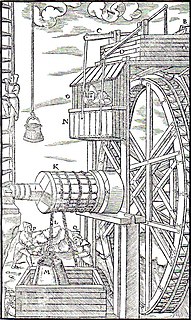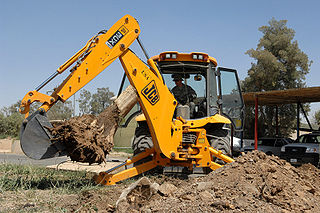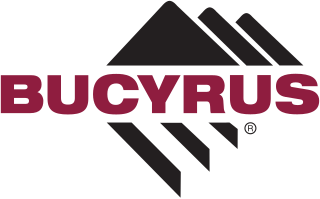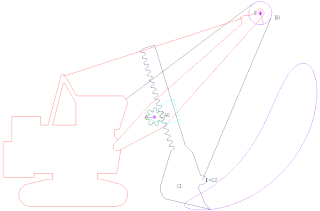
Mechanisation is the process of changing from working largely or exclusively by hand or with animals to doing that work with machinery. In an early engineering text a machine is defined as follows:
Every machine is constructed for the purpose of performing certain mechanical operations, each of which supposes the existence of two other things besides the machine in question, namely, a moving power, and an object subject to the operation, which may be termed the work to be done.
Machines, in fact, are interposed between the power and the work, for the purpose of adapting the one to the other.

William Smith Otis was an American inventor of the steam shovel. Otis received a patent for his creation on February 24, 1839.

A winch is a mechanical device that is used to pull in or let out or otherwise adjust the tension of a rope or wire rope. In its simplest form, it consists of a spool attached to a hand crank. Winches are the basis of such machines as tow trucks, steam shovels and elevators. More complex designs have gear assemblies and can be powered by electric, hydraulic, pneumatic or internal combustion drives. It might include a solenoid brake and/or a mechanical brake or ratchet and pawl which prevents it unwinding unless the pawl is retracted.

Excavators (hydraulic) are heavy construction equipment consisting of a boom, dipper, bucket and cab on a rotating platform known as the "house". The house sits atop an undercarriage with tracks or wheels. They are a natural progression from the steam shovels and often mistakenly called power shovels. All movement and functions of a hydraulic excavator are accomplished through the use of hydraulic fluid, with hydraulic cylinders and hydraulic motors. Due to the linear actuation of hydraulic cylinders, their mode of operation is fundamentally different from cable-operated excavators which use winches and steel ropes to accomplish the movements.

Garbage truck or dustcart refers to a truck specially designed to collect municipal solid waste and haul the collected waste to a solid waste treatment facility such as a landfill. Other common names for this type of truck include trash truck in the United States, and rubbish truck, junk truck, dumpster, bin wagon, dustbin lorry, bin lorry or bin van elsewhere. Technical names include waste collection vehicle and refuse collection vehicle. These trucks are a common sight in most urban areas.

A backhoe — also called rear actor or back actor — is a type of excavating equipment, or digger, consisting of a digging bucket on the end of a two-part articulated arm. It is typically mounted on the back of a tractor or front loader, the latter forming a 'backhoe loader'. The section of the arm closest to the vehicle is known as the boom, while the section which carries the bucket is known as the dipper, both terms derived from steam shovels. The boom is generally attached to the vehicle through a pivot known as the king-post, which allows the arm to pivot left and right, usually through a total of 180 to 200 degrees.

Heavy equipment refers to heavy-duty vehicles, specially designed for executing construction tasks, most frequently ones involving earthwork operations. They are also known as heavy machines, heavy trucks, construction equipment, engineering equipment, heavy vehicles, or heavy hydraulics. They usually comprise five equipment systems: implement, traction, structure, power train, control and information. Heavy equipment functions through the mechanical advantage of a simple machine, the ratio between input force applied and force exerted is multiplied. Some equipment uses hydraulic drives as a primary source of motion.

A dragline excavator is a piece of heavy equipment used in civil engineering and surface mining.

The Culebra Cut, formerly called Gaillard Cut, is an artificial valley that cuts through the Continental Divide in Panama. The cut forms part of the Panama Canal, linking Gatun Lake, and thereby the Atlantic Ocean, to the Gulf of Panama and hence the Pacific Ocean. It is 7.8 miles (12.6 km) from the Pedro Miguel lock on the Pacific side to the Chagres River arm of Lake Gatun, with a water level 85 feet (26 m) above sea level.

Marion Power Shovel Company was an American firm that designed, manufactured and sold steam shovels, power shovels, blast hole drills, excavators, and dragline excavators for use in the construction and mining industries. The company was a major supplier of steam shovels for the construction of the Panama Canal. The company also built the two crawler-transporters used by NASA for transporting the Saturn V rocket and later the Space Shuttle to their launch pads. The company's shovels also played a major role in the digging of the Hoover Dam and the New York City area with the digging of the Holland Tunnel and the extension of the Number 7 subway line to Main Street in Flushing, Queens.

Bucyrus-Erie was an American surface and underground mining equipment company. It was founded as Bucyrus Foundry and Manufacturing Company in Bucyrus, Ohio in 1880. Bucyrus moved its headquarters to South Milwaukee, Wisconsin in 1893. In 1927, Bucyrus merged with the Erie Steam Shovel Company to form Bucyrus-Erie.
Lidgerwood was a historic American engineering company famous for its boilers, winches, scrapers, hoists and cranes, particularly ones that helped build the Panama Canal. They later built logging yarders and aerial tramways, cable cars or ropeways.
The Osgood Company was a Marion, Ohio based manufacturer of heavy machinery, producing steam shovels, dragline excavators and cranes. What would eventually become Osgood Company was founded in 1910 as Marion Steam Shovel and Dredge Company by A.E. Cheney, the former head of sales for the Marion Steam Shovel Company. Marion Power Shovel acquired Osgood Company in 1954 and integrated Osgood's products into the Marion Power Shovel product line.

A mechanical stoker is a mechanical system that feeds solid fuel like coal, coke or anthracite into the furnace of a steam boiler. They are common on steam locomotives after 1900 and are also used on ships and power stations. Known now as a spreader stoker they remain in use today especially in furnaces fueled by wood pellets or refuse.

The following outline is provided as an overview of and topical guide to mining:

The Marion Steam Shovel, also known as the Le Roy Steam Shovel, is a historic Model 91 steam shovel manufactured by the Marion Steam Shovel and Dredge Company of Marion, Ohio. It is located on Gulf Road in the Town of Le Roy, New York, United States.

Joy Global Inc. was a company that manufactured and serviced heavy equipment used in the extraction and haulage of coal and minerals in both underground and surface mining. The company had manufacturing facilities in Alabama, Texas, Wisconsin, Australia, Canada, China, France, South Africa and the United Kingdom. In 2017, Joy Global was acquired by Komatsu Limited and was renamed Komatsu Mining Corp.



















